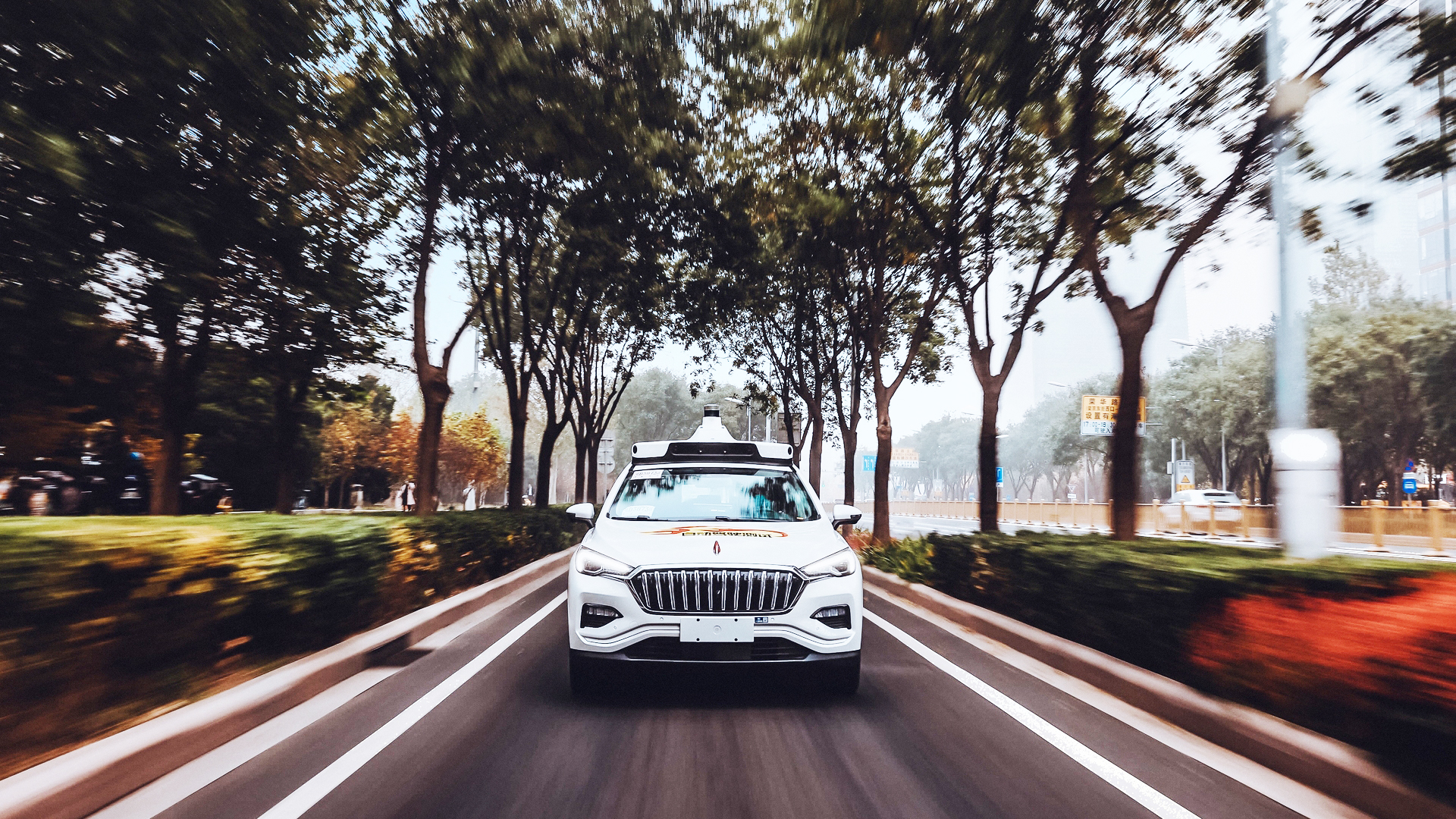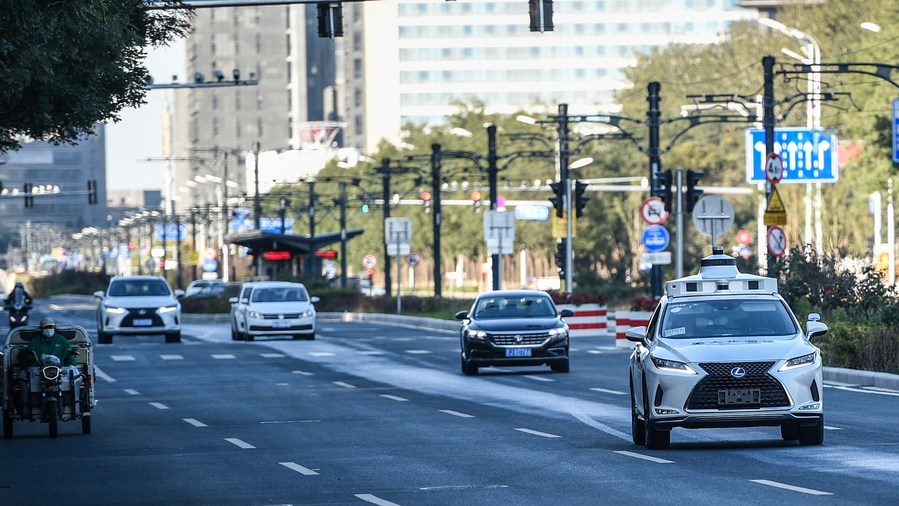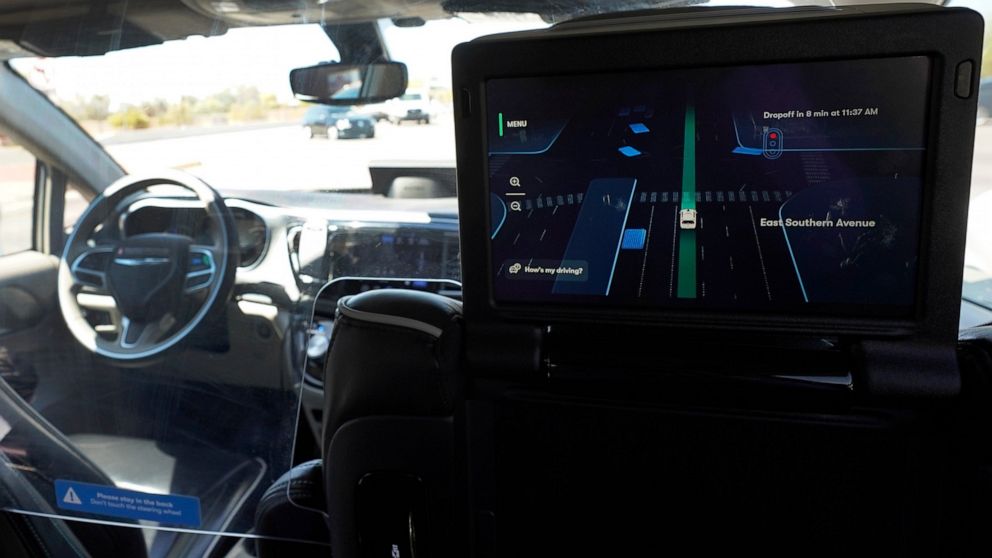03:00

For people living and working in Yizhuang, a suburban district of Beijjing, riding in a driverless taxi or robotaxi is becoming an efficient and mind-soothing new way of traveling.
"I spend less time sitting at a red light," said 31-year-old local Wang Li. "Taking robotaxis helps me save about 10 minutes of commute time every day."
In November 2021, the Beijing municipal government made Yizhuang a pilot zone for autonomous driving, allowing companies such as Chinese tech giant Baidu Inc. and self-driving start-up Pony.ai to operate paid robotaxi business in the district.
Though a human driver is still needed to be present for safety reasons, the move marked a giant leap forward in the country's push for commercial robotaxis in recent years.
In August, China's southern city of Shenzhen put the first-of-its-kind regulations for intelligent connected cars at level 3 automation into effect. The regulation covers several areas including how and where the vehicles can operate, the clarification of liabilities and auto insurance coverage in the event of an accident.
According to the U.S.-based Society of Automotive Engineering, autonomous driving ranges from level 0, which means entirely driver-piloted, to level 5, referring to fully driverless under all conditions. Level 3 requires conditional autonomous driving.
Also in August, Chongqing and Wuhan launched China's first fully driverless commercial robotaxi services in selected areas. Baidu has obtained permits to operate its robotaxis without a safety supervisor on board in designated zones in two cities. The company has been testing its vehicles for several years and has developed multiple safety measures to back up the core autonomous driving functions.
"It's really good news for our industry," said Wei Dong, vice-president and chief safety operation officer of Baidu's Intelligent Driving Group. "After this, we'll try to scale our business, improve user experience, and push to achieve a business model that would break-even."
In July, the company unveiled its sixth-generation fully autonomous vehicle known as the Apollo RT6 with a detachable steering wheel. With eight Lidar sensors serving as the eye for the vehicle, it is capable of fully-autonomous Level 4 driving.
The advancement of technology has allowed the company to price its latest model to 250,000 RMB (36,436 USD) – roughly half as much as the previous generation. The price drop also paves the way for mass production.

An autonomous vehicle (1st R) is in driverless test on a road in Yizhuang of Beijing, China, October 19, 2021. /Xinhua
An autonomous vehicle (1st R) is in driverless test on a road in Yizhuang of Beijing, China, October 19, 2021. /Xinhua
With the popularization of robotaxis, autonomous driving startups in China are in an arms race to promote their self-driven commercial vehicles.
As the world's biggest car market since 2008, China sold nearly 21.5 million passenger cars in 2021, more than twice that of the U.S., Japan and Germany combined.
By 2025, partial and conditional autonomous vehicles are expected to take up for over 50 percent of new vehicle sales in China, according to the International Trade Administration.
Other countries like U.S. and Japan have also been racing to test autonomous vehicle technology and commercialize autonomous driving.
In the U.S., Waymo, a unit of Google parent Alphabet Inc., started driverless ride-hailing service in Arizona in October 2020. In March 2022, Federal vehicle safety regulators eliminated the requirement that the production and deployment of driverless vehicles do not need to include manual controls like steering wheels or pedals.
In March 2022, Japan adopted a bill allowing level 4 autonomous vehicles to run on public roads. If approved, the road to the practical use of level 4 self-driving cars will be open for the first time in the country.

A Waymo minivan moves along a city street as an empty driver's seat and a moving steering wheel drive passengers during an autonomous vehicle ride, as passengers view a detailed viewing screen, Chandler, Ariz, U.S., April 7, 2021. /AP
A Waymo minivan moves along a city street as an empty driver's seat and a moving steering wheel drive passengers during an autonomous vehicle ride, as passengers view a detailed viewing screen, Chandler, Ariz, U.S., April 7, 2021. /AP
Approximately 1.3 million people die of road traffic accidents each year, according to the World Health Organization. Causes of these car accidents include speeding, drunk-driving and distracted driving. Experts say self-driving vehicles eliminate human errors and react faster than human drivers.
"Theoretically, autonomous driving can be safer than human driving because it avoids all traffic accidents caused by human error," said Wei. "For fully driverless robotaxis, there will be a remote parallel driving system, which allows riders to turn to human assistants for help and intervene if necessary."
But experts say current autonomous driving technology still falls short in certain scenarios.
Human drivers can use their commonsense reasoning skills to predict actions and outcomes in unanticipated situations, according to Steve Shwartz, a postdoctoral researcher in Artificial Intelligence Lab at Yale University. For instance, when a driver sees a ball roll onto the street, he knows to look out for children chasing after it. But for an autonomous vehicle, that key clue might be skipped.
"Unfortunately, no one knows how to build commonsense reasoning into cars, or into computers in general. Machine learning can only help to the extent that manufacturers anticipate every situation," wrote Steve on The Gradient, a digital magazine covering research and trends in artificial intelligence and machine learning.
For autonomous vehicles to achieve their full potential, infrastructure such as roads also need to be upgraded work together with autonomous vehicles, according to Dr. Jirui Yuan, the industry partnership program manager of the Institute for AI Industry Research at Tsinghua University.
"The cooperation between vehicles and infrastructure can help ease traffic congestion and improve road safety."

